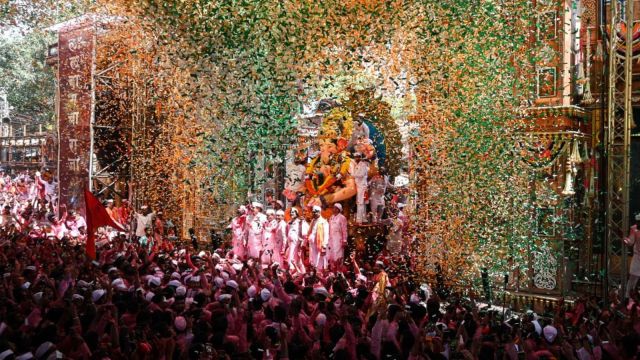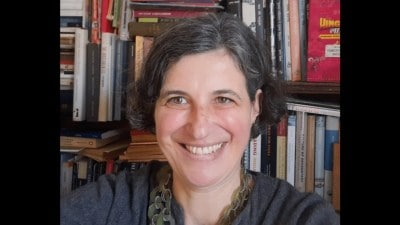How Mumbai Police ensures safety on Ganesh visarjan day since colonial era
Bandobast, the term for police deployment and security arrangements, has been an integral part of Mumbai’s history dating back to the colonial era.
 In reality, Ganesh Visarjan—the culmination of the 10-day Ganeshotsav on Anant Chaturdarshi—showcases Mumbai's effective 'Bandobast' system, which ensures the safety of millions. (Express Photo by Sankhadeep Banerjee)
In reality, Ganesh Visarjan—the culmination of the 10-day Ganeshotsav on Anant Chaturdarshi—showcases Mumbai's effective 'Bandobast' system, which ensures the safety of millions. (Express Photo by Sankhadeep Banerjee)Those who have seen Ram Gopal Varma’s cult classic Satya (1998) will remember the iconic scene where the gangster Guru Narayan is murdered by the protagonist Satya amidst the fervour of Ganesh Visarjan. Similarly, in the 2012 film Agneepath, starring Hrithik Roshan, the protagonist Vijay kills one of Kancha Cheena’s top men, with the devotional song ‘Deva Shree Ganesha’ playing in the background. These scenes juxtapose violence with religious fervour, heightening the drama. However, the cinematic chaos is far from the reality of this grand celebration.
In reality, Ganesh Visarjan—the culmination of the 10-day Ganeshotsav on Anant Chaturdarshi—showcases Mumbai’s effective ‘Bandobast’ system, which ensures the safety of millions. Both current and former police officers attest to the well-structured plan that keeps potential dangers at bay during one of the city’s most revered festivals that sees anywhere between 3,50,000-4,00,000 people congregating around Chowpatty on the final Visarjan day.
 Screengrabs of the 2012 film Agneepath and the 1998 film Satya (right), both of which saw a chilling murder during the Ganesh Visarjan ceremony.
Screengrabs of the 2012 film Agneepath and the 1998 film Satya (right), both of which saw a chilling murder during the Ganesh Visarjan ceremony.
Bandobast: Mumbai’s safety net
Bandobast, the term for police deployment and security arrangements, has been an integral part of Mumbai’s history dating back to the colonial era. Alongside their duties during elections and VIP movements, the Mumbai Police ensures the smooth functioning of Ganesh Visarjan through extensive planning and coordination across multiple departments.
“It is a well-laid-out plan involving synergies between various agencies — from the Intelligence Bureau (IB) to the State Reserve Police Force (SRPF), Rapid Action Force (RAF), Quick Response Team (QRT), local police, and even the BMC’s Roads, Traffic, and Health departments,” explains D. Sivanandhan, former Police Commissioner of Mumbai.
Preparations begin two months in advance with the Police Commissioner calling representatives from 250–300 major sarvajanik pandals, including Lalbaugcha Raja, Keshavji Naik Chawl, and GSB Sarvajanik Ganeshotsav Samiti. The guidelines are issued and agreed upon.
To manage the crowd, police are deployed throughout the 10-day period but additional forces are called for Visarjan. According to a press note from the Mumbai police, over 19,000 personnel were deployed in 2023, including eight additional police commissioners, 25 deputy commissioners, 45 assistant commissioners, 2,866 officers, and 16,250 constables. There were also 35 platoons of SRPF, RAF, QRT commandos, and home guards on duty.
However, the manpower is still stretched thin in comparison to the crowd. “Police personnel don’t get leaves during this period, and they often don’t get adequate rest, sometimes not even the chance to go home to shave or shower,” Sivanandhan noted.
On the day of Visarjan, the work for police personnel starts early in the day and ends only after Lalbaugcha Raja is immersed the following morning. When Eid-e-Milad falls on the day after Visarjan — as happened last year — there is absolutely no rest for policemen. Senior officers remain on the ground to ensure their juniors stay motivated.
Nuisance from gangsters only in films
Mumbai’s underworld, which dominated the city from the 1970s to the early 2000s, had their own relationship with Ganeshotsav. While filmmakers have often used Ganesh Visarjan as a dramatic backdrop for climactic moments of murder or confrontation — featured in films like Vaastav (1999), Agneepath (2012), Don (2006), Shootout at Lokhandwala (2007), and Once Upon a Time in Mumbaai (2010) — the reality on ground is different.
Sivanandhan, who played a key role in curbing the criminal activities of figures like Chhota Rajan and Arun Gawli, noted that these gangsters were also devout participants in Ganeshotsav.
“They wouldn’t harm public sentiment,” he said, adding, “Chhota Rajan funded the Sahyadri Krida Mandal, and Varadarajan Mudaliar had a prominent pandal in Matunga. They invested crores in the festival. Since the late 1970s, I’ve seen the festival foster a sense of communal unity, similar to Durga Puja in Kolkata.”
Echoing this, police historian Deepak Rao pointed out that some pandals still receive backing from underworld figures and attract high-profile visitors. “Ganpati is highly respected, and conflicts are rare during the festival,” Rao said.
While gangsters didn’t disrupt the festival, terrorism remained a concern. “From a terrorism perspective, we deploy snipers and place personnel with binoculars on rooftops to monitor the crowds,” said an officer on condition of anonymity.
The police also work to prevent communal tension. “In some areas like Jalgaon district in Maharashtra, we had to manage 36 communal hotspots during processions. Throwing gulaal is a big part of the festivity, so we’d set up white sheets in front of mosques to prevent it from entering the premises,” Sivanandhan recalled. Minor issues, such as deliberate delays in processions or nuisance caused by drinking, are handled on the spot by local officers.
Managing Girgaon Chowpatty: The heart of Visarjan
Although the film doesn’t explicitly name immersion points, they are often characterised after Girgaon Chowpatty. One of the most popular immersion spots in Mumbai, Girgaon witnesses around 4,000 idol immersions annually, with nearly 1,000 coming from prominent sarvajanik pandals featuring giant idols such as Lalbaugcha Raja, Ganesh Gallicha Raja, and Tejukyacha Raja, many of which are immersed in the wee hours following lengthy processions. The crowd at Chowpatty has also been growing every year, with police estimating the floating crowd to be around 400,000 people this year.
To manage the swelling crowds, several measures have been implemented. Notably, in 2005, Girgaon Chowpatty was fully brought under the jurisdiction of the DB Marg police station, previously shared with Gamdevi. Additionally, the removal of the foot overbridge near the entrance, which obstructed large idols, has facilitated smoother processions.
Historical conflicts have prompted changes to improve management. “There was an instance a decade ago when workers from two major Ganesh pandals clashed on their way to Girgaon Chowpatty. A verbal altercation arose because one group was moving slowly and blocking others,” shared a police officer. In response, the police now allocate specific times and routes for each pandal. Lalbaugcha Raja, the most prominent, is given the last slot, with its immersion scheduled for 6 am the following morning.
Technological advancements in Bandobast
Over time, Bandobast has evolved to match the city’s growing population and the scale of the festival. In 2011, the then Home Minister RR Patil inaugurated the beat chowki at Girgaon Chowpatty, and CCTV cameras were installed to monitor crowds.
“This brought a huge change in our policing. It was the first time we used CCTV cameras for crowd monitoring,” says a retired officer who served at both Gamdevi and DB Marg police stations.
In recent years, the inclusion of drones has further improved surveillance. Around six to seven drones are now deployed at Girgaon alone. “The crowd is so dense that it can take an hour to cover a short stretch during a conflict. Thanks to drones, we can monitor any point in real time,” notes a police officer on duty.
One of the major concerns today is that a lot of children get separated from their parents. “After CCTV cameras, it was brought to light that we should also have an announcement system in the Chowpatty. While the system helps in managing the crowd, it plays a huge role in reuniting the children who get lost in the crowd,” an officer added.
With large idols weighing hundreds of kilograms, the police also place 600-800 iron plates near the shore to prevent the sand from collapsing under the weight. Only one vehicle per idol, whether household or sarvajanik, is allowed to enter Chowpatty to ensure smooth movement.
To manage traffic, several roads are closed or made one-way during Visarjan. This year, the police is expecting the traffic on the road to be more manageable, courtesy the Coastal Road, which has also been made operation round the clock during the Ganeshotsav.
Almost all the police officers The Indian Express spoke to also give credit to Lord Ganesha. “Ganeshotsav sees a massive movement of people. There is a possibility of so many things going wrong. While the police and other bodies have been trying their best, the credit goes to the Bappa for ensuring that everything goes smoothly year after year,” signed off Sivanandhan.







